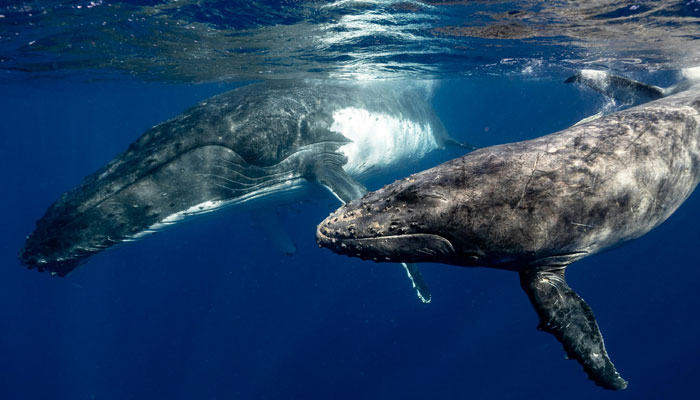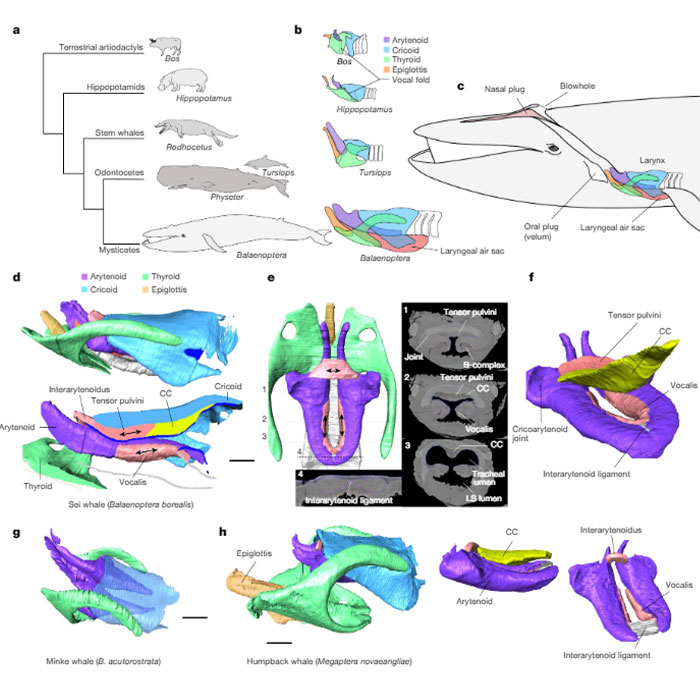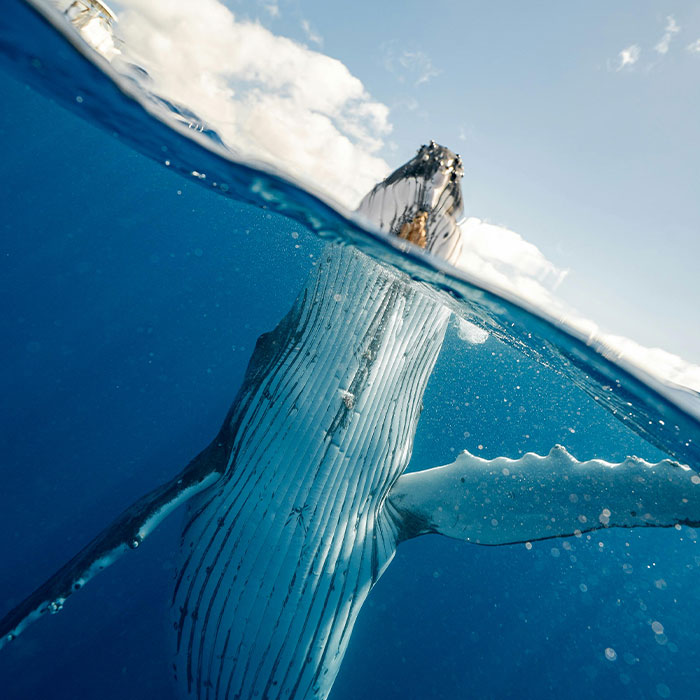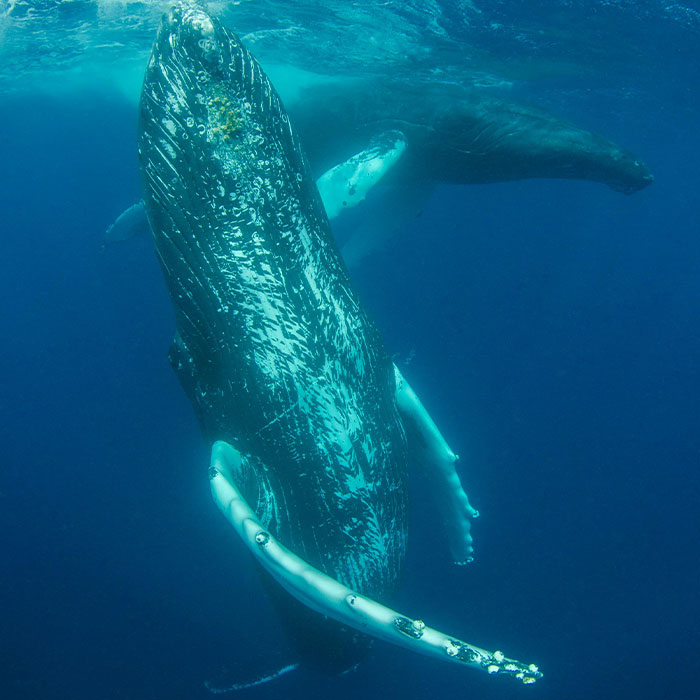HighlightsScientists finally solved the mystery behind baleen whales' songs, tracing it to special voice box structures.Baleen whales use low-frequency calls for communication, crucial for their social and reproductive behaviors.Scientists said that human vessel noise disrupts whales' communication, making it hard for them to interact at significant ocean depths.
Baleen whales, which are part of a specific group of whales known as mysticetes, are notable for possessing baleen plates in their mouths instead of teeth. Mysticetes include species such as humpback whales, blue whales, and grey whales.
These types ofwhalesutilize vocalizations to navigate their intricate social and reproductive behaviors in expansive, opaque marine environments, the scientists noted.
The researchers have found the evolutionary adaptations of the marine animals’ laryngeal structures (components found within the larynx) for efficient sound production, contrasting them with toothed whales of the odontocetes species, which have a nasal vocal organ instead.
Scientists found how baleen whales make their mesmerizing songs, attributing it to specialized anatomical structures and low-frequency calls

Image credits:Pexels/Elianne Dipp
“These structures allow some of the largest animals that ever lived to efficiently produce frequency-modulated, low-frequency calls,” the scientists wrote in their paper.
Nevertheless, the researchers have found that the unique anatomical features of thewhales‘ laryngeal structures impose significant restrictions on the range of frequencies and depths at which they can effectively communicate.
The researchers have found the evolutionary adaptations of the marine animals’ laryngeal structures

Image credits:Nature
In other words, we disturb whales’ communication at sea with our big boats and whatnot!
When ancestral whales (the early evolutionary predecessors of modern whales) transitioned from land to sea, they faced challenges, particularly regarding their vocal communication. They needed to adapt their laryngeal structures to accommodate both breathing and vocalizationunderwater.
One adaptation seen in odontocetes involved the evolution of a nasal vocal organ and modifications to the larynx to effectively seal the airway during diving.
Human vessel noise disrupts whales’ communication and hinders their ability to interact effectively in the ocean depth

Image credits:Pexels/Adam Ernster
In contrast, mysticetes developed a vocal tract that retained features for both respiratory and phonatory functions, differing significantly from both odontocetes and their land-dwelling relatives.
“In the respiratory tract, mysticetes evolved nasal and oral plugs, to protect the airways from water when breathing and feeding, and a laryngeal air sac that is hypothesized to allow the recycling of air during phonation,” thescientists explained.
They further noted: “In the larynx, long, rigid, cylinder-like arytenoid cartilages form a U shape that allows massive expiratory and inspiratory air flows during surface breathing and lacks the standard mammalian vocal folds that normally run from the tip of the arytenoid to the thyroid cartilage.
“But it remains unclear how mysticetes phonate with this unusual larynx.”
The larynx of mysticete whales continues to serve as a crucial organ for vocalization

Image credits:Pexels/ Elianne Dipp
The paper described the researchers’ study to understand the mechanism around the whale sounds, which involved the examination of the voice boxes of sei (a species of baleen whale), common minke (another species of baleen whale), and humpback whales using advanced imaging techniques.
The scientists eventually found the unique structures, previously mentioned, in these whales’ voice boxes that help them produce the puzzling sounds underwater.
They also discovered specific muscles that likely help control vocalization and tension in these structures, which they referred to as TAFs (transverse arytenoid folds).
The scientists’ data conclusively demonstrated that the larynx of mysticete whales continues to serve as a crucial organ for vocalization despite having undergone various anatomical adaptations.
The laryngeal novelties in mysticetes allow for successful low-frequency communication over large distances in opaque water

Image credits:Pexels/Ben Phillips
They continued: “The laryngeal novelties we document in mysticetes allow for successful low-frequency communication over large distances in opaque water.
“However, our work also establishes that maximally 300-Hz calls produced at maximally 100-meter diving depths pose insurmountable physiological constraints on communication in most mysticete species, with two important implications.
“First, the active space in which these animals can use two-way communication is restricted and does not span oceans through deep sound channels.
“Second, these frequency and depth regions overlap with anthropogenic noise fromvessels, which today dominates this band of 30–300 Hz near the ocean surface.”
You can listen to the haunting song of humpback whales below:
“Sound is absolutely crucial for their survival because it’s the only way they can find each other to mate in the ocean,” Profesor Coen Elemans of the University of Southern Denmark, who led the study, told theBBC.
He added: “[These are some] of the most enigmatic animals that ever lived on the planet.
“They are amongst the biggest animals, they’re smart, and they’re highly social.”
The way Baleen whales produce their haunting songs has been a mystery until now. Professor Elemans reportedly said it was “super-exciting” to have figured it out.
The new discovery stunned many readers


 You May Like50 Hilarious Animals Who Lost The Plot And Got Caught Going “Goblin Mode” (New Pics)Indrė LukošiūtėRarest Animal In The World And Other 62 Species Near ExtinctionLinas Simonaitis85 Animal Tattoo Ideas That Embrace Simplicity And RealismLarysa Perih
You May Like50 Hilarious Animals Who Lost The Plot And Got Caught Going “Goblin Mode” (New Pics)Indrė LukošiūtėRarest Animal In The World And Other 62 Species Near ExtinctionLinas Simonaitis85 Animal Tattoo Ideas That Embrace Simplicity And RealismLarysa Perih
Indrė Lukošiūtė
Linas Simonaitis
Larysa Perih
Animals